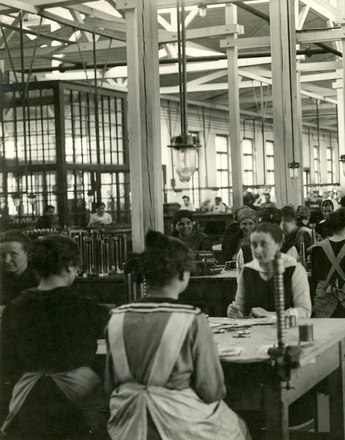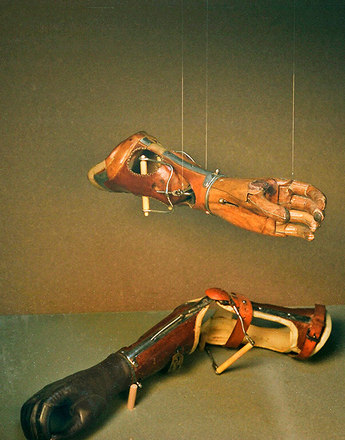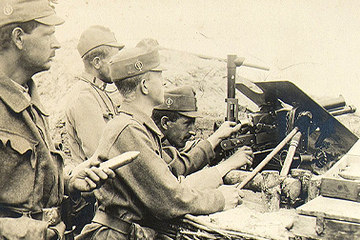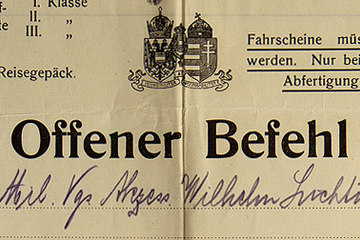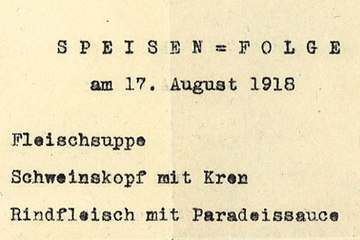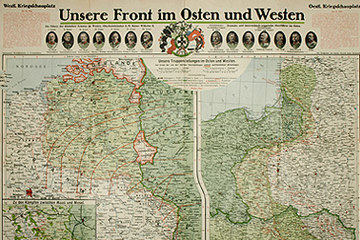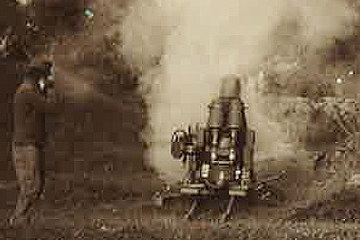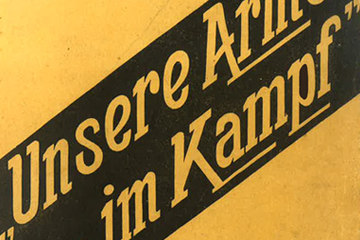
“Fallen soldiers in front of the Russian barrier”, Eastern Front, photograph, 1915, extract from Leopold Wolf's war photo album
Copyright: Sammlung Frauennachlässe, Institut für Geschichte der Universität Wien/Fotografie: Angelika Spangel
Partner: Sammlung Frauennachlässe, Institut für Geschichte der Universität Wien
-
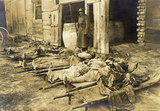
Wounded soldier, photograph, undated
Copyright: Sammlung Frauennachlässe, Institut für Geschichte der Universität Wien
Partner: Sammlung Frauennachlässe, Institut für Geschichte der Universität Wien -
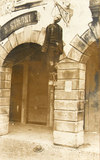
“A traitor”, Fritz Ortlieb war photo album, 1917
Copyright: Sammlung Frauennachlässe, Institut für Geschichte der Universität Wien/Fotografie: Angelika Spangel
Partner: Sammlung Frauennachlässe, Institut für Geschichte der Universität Wien -
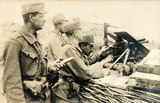
“Infantry artillery in position”, Fritz Ortlieb war photo album, c. 1916
Copyright: Sammlung Frauennachlässe, Institut für Geschichte der Universität Wien/Fotografie: Angelika Spangel
Partner: Sammlung Frauennachlässe, Institut für Geschichte der Universität Wien -

“Shell bursting at Majdan”, Russian theatre of war, around 1916/1917, extract from Fritz Ortlieb's war photo album
Copyright: Sammlung Frauennachlässe, Institut für Geschichte der Universität Wien/Fotografie: Angelika Spangel
Partner: Sammlung Frauennachlässe, Institut für Geschichte der Universität Wien -

“Flamethrower”, Russian theatre of war, around 1916/1917, extract from Fritz Ortlieb's war photo album
Copyright: Sammlung Frauennachlässe, Institut für Geschichte der Universität Wien/Fotografie: Angelika Spangel
Partner: Sammlung Frauennachlässe, Institut für Geschichte der Universität Wien
Violence and death were omnipresent on the fronts in the First World War, and the soldiers had to face this practically every day. The fear of being wounded and their own deaths was constantly present, as was the visual presence of death in the form of “fallen” enemy soldiers and their own comrades. Moreover, they were constantly confronted with violence and death in combat and the actual act of killing; such experiences were completely new and extremely dramatic for most of the recruits of 1914.
In the great majority of letters sent home by the soldiers to their relatives, descriptions of their acts of killing were usually left out. Besides the official censorship by the Monarchy’s military apparatus, the soldiers’ own so-called self-censorship played a great role. This prevailed firstly out of consideration to those they loved at home, but on the other hand it also derived from ideas and (self-)interpretations of a “soldierly manliness”. The experiences and the fact of living every day with the violence of war, suffering and death were usually very difficult to write about in letters, which is why there is little mention of the wounds and death of comrades. This applies as well, states Christa Hämmerle, to Austrian literature commemorating the First World War, where “explicit references to the ‘craft of killing’, hand-to-hand combat and the palpable physical and mental consequences which the soldiers had to cope with, are rare [...]“.
Death in war wore many masks. It could appear in the form of illness, or in the mountains being buried alive in an avalanche or falling, or being mortally wounded by gunshot. The historian Benjamin Ziemann has shown that the artillery was the weaponry mainly responsible for wounds and deaths among the soldiers on the Western Front. Thus 76 % of all wounds suffered by French soldiers came from artillery gunshot, a frequency that according to surveys in 1917 also applied to the soldiers of the German Army. Meanwhile artillery soldiers were exposed to less risk of being killed than for example infantry soldiers. Statistics for Austria demonstrate that the infantry had by far the highest losses. Alone by March 1915, 70,497 men from the ranks of the infantry were dead, 358,480 wounded and another 369,548 missing. By November 1918 these figures had risen to 330,226 dead, 1,364,161 wounded and 822,535 missing.
Regardless of how a soldier was wounded or killed, all ‘losses’ – and this meant not only the loss of a human life, but also of ‘fighting power’ through wounding, sickness, imprisonment or being missing – were recorded in lists that were then sent directly to the War Office.
In principle all the dead on one’s own or opposing side were to be secured, identified and buried. This was not only for hygienic reasons as protection against disease and epidemics, but was also a last tribute and gesture of honour for the fallen. This succeeded very rarely, and many of the “fallen for the Fatherland” could not be identified or were simply no longer identifiable. Likewise, many of them remained without a final resting place, as documented by the Tyrolean Kaiserjäger Johann Mittermaier in his diary: “The fallen were lying everywhere. Gruesome corpses, decaying or shrunken, with cramped hands and feet and gaping mouth. (…) One evening, in the pallid light of the moon, Leutnant P. ordered us to clear this mountain peak (…) of the corpses. On the saddle, a steep, deep ravine yawned upwards towards the north. The dead were to be dropped down there. Two men grasped a corpse under the knees and armpits, led it to the brink and swung it over and down. No one mentioned identification.”
Translation: Abigail Prohaska
Brandauer, Isabelle: Menschenmaterial Soldat. Alltagsleben an der Dolomitenfront im Ersten Weltkrieg 1915–1917, Innsbruck 2007
Die Habsburgermonarchie und der Erste Weltkrieg. Bd. XI, 2. Teilband: Weltkriegsstatistik Österreich-Ungarn 1914 – 1918. Bevölkerungsbewegung, Kriegstote, Kriegswirtschaft, bearbeitet von: Rumpler, Helmut und Schmied-Kowarzik, Anton, Wien 2014, Tabelle 25: Verluste nach Waffengattungen 1915-1918, 187–189, hier: 187
Hämmerle, Christa: Soldaten, in: Labanca, Nicola/Überegger, Oswald (Hrsg.): Krieg in den Alpen. Österreich-Ungarn und Italien im Krieg, Wien/Köln/Weimar 2014, im Druck
Rauchensteiner, Manfried: Kriegermentalitäten. Mistzellen aus Österreich-Ungarns letztem Krieg, in: Dornik, Wolfram/Walleczek-Fritz, Julia/Wedrac, Stefan (Hrsg.): Frontwechsel. Österreich-Ungarns „Großer Krieg“ im Vergleich, Wien/Köln/Weimar 2014
Reimann, Aribert: Wenn Soldaten vom Töten schreiben – Zur soldatischen Semantik in Deutschland und England, 1914–1918, in: Gleichmann, Peter/Kühne, Thomas (Hrsg.): Massenhaftes Töten. Kriege und Genozide im 20. Jahrhundert, Essen 2004, 307–319
Überegger, Oswald: Verbrannte Erde und „baumelnde Gehenkte“. Zur europäischen Dimension militärischer Normübertretungen im Ersten Weltkrieg, in: Neitzel, Sönke / Hohrath, Daniel (Hrsg.): Kriegsgreuel. Die Entgrenzung der Gewalt in kriegerischen Konflikten vom Mittelalter bis ins 20. Jahrhundert, Paderborn/München/Wien 2008, 241–278
Ziemann, Benjamin: Soldaten, in: Hirschfeld, Gerhard/Krumeich, Gerd/Renz, Irina (Hrsg.): Enzyklopädie Erster Weltkrieg, 3. Auflage, Paderborn/München/Wien 2009, 155–168
Quotes:
„explicit references to ...“: quoted from: Hämmerle, Christa: Soldaten, in: Labanca, Nicola/Überegger, Oswald (Hrsg.): Krieg in den Alpen. Österreich-Ungarn und Italien im Krieg, Wien/Köln/Weimar 2014, in the press
„Thus 76 % of all wounds ...“: figures quoted from: Ziemann, Benjamin: Soldaten in: Hirschfeld, Gerhard/Krumeich, Gerd/Renz, Irina (Hrsg.): Enzyklopädie Erster Weltkrieg, , 3rd edition, Paderborn/München/Wien 2009, 157
„Alone by March 1915 ...“: figures quoted from: Die Habsburgermonarchie und der Erste Weltkrieg. Vol. XI, 2nd part vol: Weltkriegsstatistik Österreich-Ungarn 1914–1918. Bevölkerungsbewegung, Kriegstote, Kriegswirtschaft, edited by: Rumpler, Helmut und Schmied-Kowarzik, Anton, Vienna 2014, table 25: Verluste nach Waffengattungen 1915-1918, 187
„The fallen were lying ...“: Mittermaier, Johann: Der Schrecken des Krieges. Die Erinnerungen eines Südtiroler Kaiserjägers aus dem 1. Weltkrieg, Brixen 2005, 51, quoted from: Brandauer, Isabelle: Menschenmaterial Soldat. Alltagsleben an der Dolomitenfront im Ersten Weltkrieg 1915–1917, Innsbruck 2007, 259

